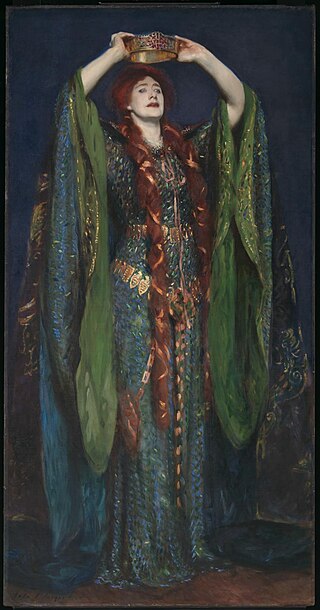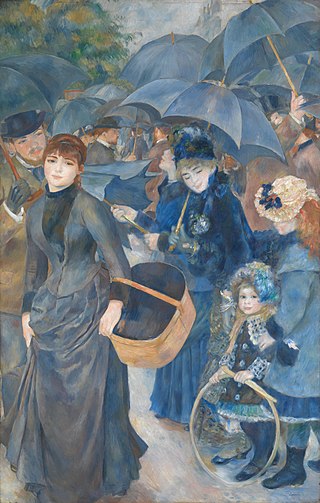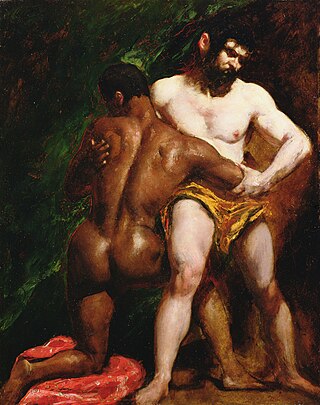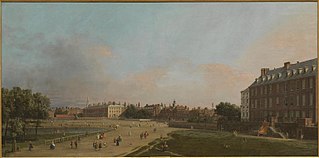
A hackney or hackney carriage is a carriage or car for hire. A hackney of a more expensive or high class was called a remise. A symbol of London and Britain, the black taxi is a common sight on the streets of London. The hackney carriages carry a roof sign TAXI that can be illuminated to indicate their availability for passengers.

The hansom cab is a kind of horse-drawn carriage designed and patented in 1834 by Joseph Hansom, an architect from York. The vehicle was developed and tested by Hansom in Hinckley, Leicestershire, England. Originally called the Hansom safety cab, it was designed to combine speed with safety, with a low centre of gravity for safe cornering. Hansom's original design was modified by John Chapman and several others to improve its practicability, but retained Hansom's name.

Sir Edwin Henry Landseer was an English painter and sculptor, well known for his paintings of animals – particularly horses, dogs, and stags. His best-known works are the lion sculptures at the base of Nelson's Column in Trafalgar Square.
Events from the year 1859 in art.

George Shillibeer was an English coachbuilder.

A brougham is a 19th century four-wheeled carriage drawn by a single horse. It was named after the politician and jurist Lord Brougham, who had this type of carriage built to his specification by London coachbuilder Robinson & Cook in 1838.

A horse-drawn vehicle is a piece of equipment pulled by one or more horses. These vehicles typically have two or four wheels and were used to carry passengers or a load. They were once common worldwide, but they have mostly been replaced by automobiles and other forms of self-propelled transport but are still in use today.

Walter Hancock was an English inventor of the Victorian period. He is chiefly remembered for his steam-powered road vehicles, but also received a patent for preparing and cutting natural rubber into sheets. He was the younger brother of Thomas Hancock, the inventor of rubber mastication who is also claimed by some to be the inventor of rubber vulcanization.

The Lady of Shalott is a painting of 1888 by the English painter John William Waterhouse. It is a representation of the ending of Alfred, Lord Tennyson's 1832 poem of the same name. Waterhouse painted three versions of this character, in 1888, 1894 and 1915. It is one of his most famous works, which adopted much of the style of the Pre-Raphaelite Brotherhood, though Waterhouse was painting several decades after the Brotherhood split up during his early childhood.

A coach is a large, closed, four-wheeled, passenger-carrying vehicle or carriage usually drawn by two or more horses controlled by a coachman, a postilion, or both. A coach has doors in its sides and a front and a back seat inside. The driver has a raised seat in front of the carriage to allow better vision. It is often called a box, box seat, or coach box. There are many types of coaches depending on the vehicle's purpose.

A cabriolet is a light horse-drawn vehicle, with two wheels and a single horse. The carriage has a folding hood that can cover its two occupants, one of whom is the driver. It has a large rigid apron, upward-curving shafts, and usually a rear platform between the C springs for a groom. The design was developed in France in the eighteenth century and quickly replaced the heavier hackney carriage as the vehicle for hire of choice in Paris and London.

A horse-bus or horse-drawn omnibus was a large, enclosed, and sprung horse-drawn vehicle used for passenger transport before the introduction of motor vehicles. It was mainly used in the late 19th century in both the United States and Europe, and was one of the most common means of transportation in cities. In a typical arrangement, two wooden benches along the sides of the passenger cabin held several sitting passengers facing each other. The driver sat on a separate, front-facing bench, typically in an elevated position outside the passengers' enclosed cabin. In the main age of horse buses, many of them were double-decker buses. On the upper deck, which was uncovered, the longitudinal benches were arranged back to back.

Bigger Trees Near Warter or ou Peinture en Plein Air pour l'age Post-Photographique is a large landscape painting by British artist David Hockney. Measuring 460 by 1,220 centimetres or 180 by 480 inches, it depicts a coppice near Warter, Pocklington in the East Riding of Yorkshire and is the largest painting Hockney has completed.

Ellen Terry as Lady Macbeth is an oil painting by John Singer Sargent, now in Tate Britain, in London. Painted in 1889, it depicts actress Ellen Terry in a famous performance as Lady Macbeth in William Shakespeare's tragedy Macbeth, wearing a green dress decorated with iridescent beetle wings. The play was produced by Henry Irving at the Lyceum Theatre, London, with Irving also playing Macbeth opposite Terry. Sargent attended the opening night on 29 December 1888 and was inspired to paint Terry's portrait almost immediately.

The Derby Day is a large oil painting showing a panoramic view of The Derby, painted by the English artist William Powell Frith over 15 months from 1856 to 1858. It has been described by Christie's as Frith's "undisputed masterpiece" and also "arguably the definitive example of Victorian modern-life genre."

The Umbrellas is an oil-on-canvas painting by Pierre-Auguste Renoir, painted in two phases in the 1880s. It is owned by the National Gallery in London as part of the Lane Bequest but is displayed alternately in London and at the Dublin City Gallery The Hugh Lane. From May 2013 to 2019, it returned to Dublin for a six-year period. It is now in the National Gallery London.

The Last Judgement is a triptych of oil paintings by the British artist John Martin, created in 1851–1853. The work comprises three separate paintings on a theme of the end of the world, inspired by the Book of Revelation. The paintings, The Plains of Heaven, The Last Judgement, and The Great Day of His Wrath, are generally considered to be among Martin's most important works, and have been described by some art critics as his masterpiece.

The Wrestlers is an oil painting on millboard by English artist William Etty, painted around 1840 and currently in the York Art Gallery, in York, England. It depicts a wrestling match between a black man and a white man, both glistening with sweat and under an intense light emphasising their curves and musculature. While little documentation of the painting exists prior to 1947, it is likely that it was painted over a period of three evenings at the life class of the Royal Academy.

The Bayswater Omnibus is an 1895 oil painting by George William Joy. It has been part of the Museum of London's collection since 1966. The genre painting depicts a scene inside a horse-drawn omnibus of the London General Omnibus Company. Joy borrowed a bus from the company while he was working on his painting.

Old Horse Guards is a 1749 landscape painting by the Italian artist Canaletto. It depicts the view from St James's Park of the Horse Guards building in London. Built during the reign of Charles II it served as the headquarters of the British Army. At the time he painted it the existing building was due to be pulled down and replaced by the larger building designed by William Kent that still stands today. The painting offers a wider view of Whitehall in the mid-eighteenth century. On the right of the picture is the rear of Downing Street. It is also known by the longer title The Old Horse Guards from St James's Park.




















